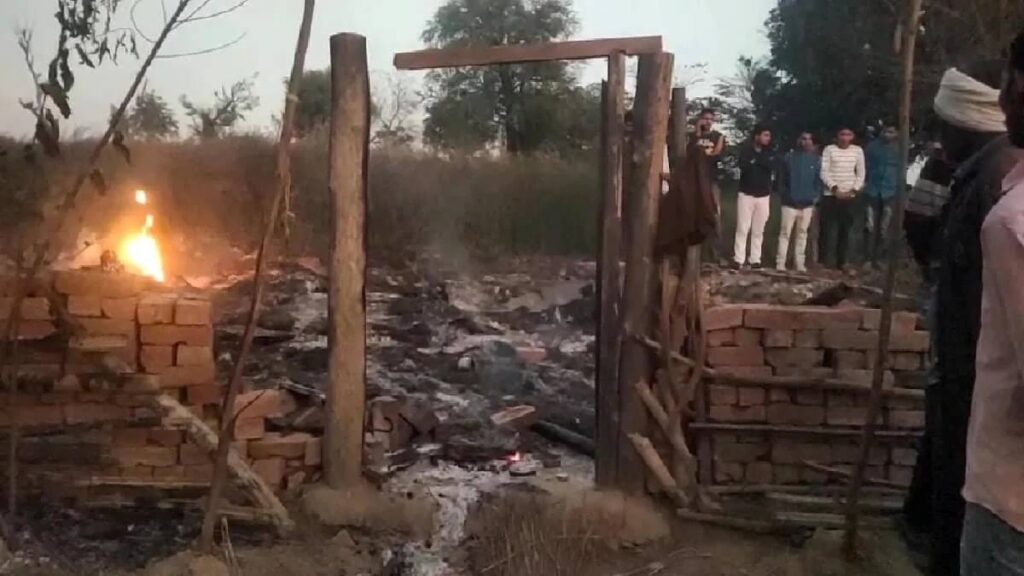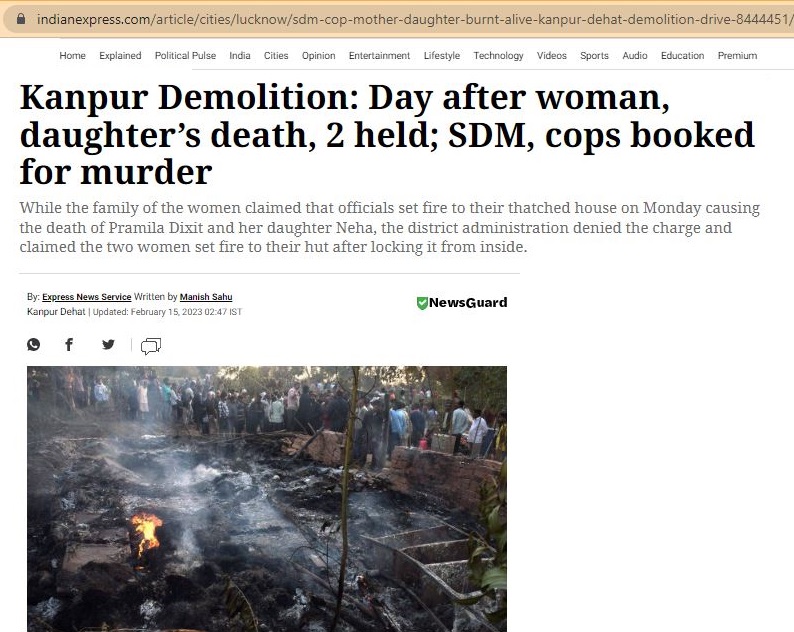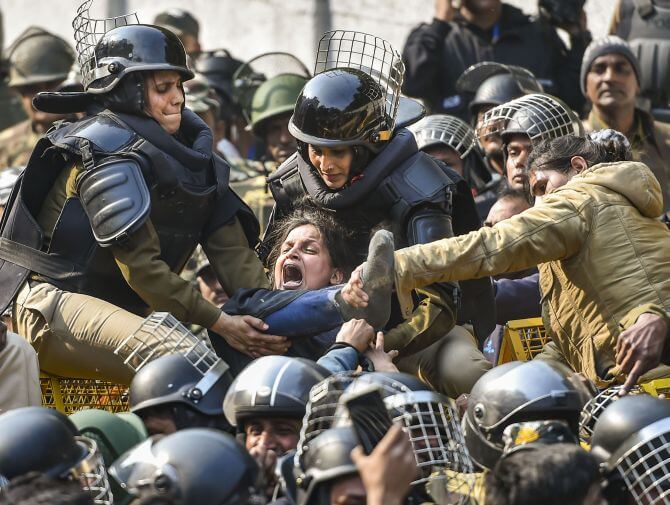The police are the public and the public are the police; the police being only members of the public who are paid to give full-time attention to duties which are incumbent on every citizen in the interests of community welfare and existence” – Robert Peel, founder of modern policing


Recently a mother and her daughter died in a fire in Madauli village in Kanpur in the course of an anti-encroachment drive to reclaim gram sabha land.
It is generally believed that the mother-daughter perished in the burning hut. However, it is not yet known – how the hut caught fire in the first place. The family members allege that the police set the hut on fire while the mother and daughter were inside. On the other hand, the police and the administration claim that the two women set fire to their hut after locking it from the inside.

Over 39 people, including an SDM, SHO, and the JCB operator have been booked on murder and other charges— this has suppressed public anger for the time being.
The exact circumstances of their death will only be clear once the trial is over — maybe a few years later. For the moment, the authenticity of the statements given by the witnesses remains a mystery.
Aren’t we missing the real issue?
Whenever such incidents take place, the people, media, and politicians get carried away by the intensity of emotions and outrage — there is no cool, level-headed, professional examination of the issue. This is precisely the reason, why there is a need for a systemic analysis of the larger issues of law enforcement, governance, and human rights that arise from such incidents and find the missing links.
The basic legal and administrative issue is what the police and the public are supposed to do or what they should do within the boundaries or parameters of the law — without breaking one’s head against the wall in trying to find the question of which side is right or wrong (this can be decided later by a court of law). Opposing any police action is extremely common in India. This is the issue that needs a detailed analysis here.
People threaten the police that they will commit suicide
In the recent incident in Kanpur, if the allegation of the deceased women’s family is correct, the officials committed a horrible crime—even though it is difficult to imagine that one could be so inhuman as to set fire to a structure knowing that people were inside. But, nothing in this world is improbable either. On the other hand, the version given by the officials also appears quite probable, particularly in view of the fact that historically people threaten the police to commit suicide. According to the Indian Express, a team of officials and police had gone to the village to reclaim the gram sabha land (which is public property) which had allegedly been encroached on by the deceased’s husband. The officials believed that he had built a hut on the encroached land and had placed a religious structure outside it. When the officials and police were busy removing the encroachment, the woman slipped past them and locked the hut from the inside. A few minutes later the hut was a blazing inferno with flames all over the place. The government official could only rescue the lady’s husband and her son, but she could not be saved. A policeman also suffered minor burn injuries while trying to save them.
According to some other media

According to media reports DM Neha Jain had gone to the village along with a police team to stop the woman’s family from building a temple inside their illegally occupied premises. To prevent them from doing so the woman and her daughter hid inside the house and set it on fire on their own.
The threat to commit suicide as a means of self-defense is a common practice in Indian cultural consciousness. The police come across such drama almost every day during agitations. Readers may recall the self-immolation attempt by Rajiv Goswami during the 1990 anti-Mandal agitation- Veeru (Dharmendra) in the Bollywood film Sholay who climbs a water tank and threatens to jump if his demand to marry Basanti is not met, is not just fiction.

Ironically people in India don’t just stop after threatening suicide; some of them even attack the police team as if threatening and attempting suicide is their birthright and the police are responsible for all the bad things in their life! In Sawai Madhopur, Rajasthan, SHO Phool Mohammad was burnt alive in his police jeep by a vicious mob that knocked him unconscious by throwing stones because one of them called Rajesh Meena climbed up a water tank and jumped to death because he was demanding the arrest (by 5 p.m. on that very day!) of the accused who had, nearly a month ago, killed an elderly woman during a robbery Nearly a dozen cops were injured in the incident.

Another such incident reportedly occurred at Jantar Mantar, New Delhi in 2015, when Gajendra Singh a farmer from Dausa in Rajasthan hanged himself in front of more than a thousand people at a Kisan rally convened by the Aam Aadmi Party to protest against the Land Acquisition Bill. Rajendra Singh climbed a tree, with a broom in hand, and remained there for about half an hour even while the crowd below kept urging him to come down. But instead of heading to their demands he tied a cloth around his neck, wrapped the other end around the branch of a tree, and hanged himself.

In Bulandshahar, UP one person called Akil while trying to escape from arrest fell from the roof of his house and later died in Delhi where he was taken for medical treatment. His family and relatives alleged that the police pushed him down from the roof, so they blocked the roads to seek action against the policemen responsible for his death. In Hallomajra, Chandigarh, two cops were raiding a gambling den when an accused fell off the terrace and died. Even his family alleges that the cops kicked him while frisking him, which is why he fell down.

Last June, Kartik Popli, son of Sanjay Popli, a Punjab IAS officer, who was then under arrest over corruption charges, died of gunshot injuries at his Chandigarh residence while a vigilance team was searching the house. The police said that Kartik Popli, a law graduate, killed himself on the first floor of the house with a licensed gun, whereas the IAS officer alleged murder by the police. Incidentally, the vigilance team recovered nearly 12 kg of gold and silver from a store in the yard and said that the family appeared to be in“panic” because of the recovery which was “a great loss”.
Threat to implicate police in trumped-up charges
Quite often, an implicit threat is made by the public to ward off trumped-up charges, particularly of molestation, etc. Unless there is a video recording of the exact proceedings, such charges are difficult to refute. For example, while conducting a search the women themselves could tear off their clothes and allege they were indecently touched or manhandled by the policemen who wanted to outrage their modesty, the cops may find it difficult to prove that they were innocent and did not do anything objectionable. This is precisely the reason why women are purposefully positioned in front of the crowd. The Shaheen Bagh protest is a recent example where the anti-CAA agitators held the commuters to ransom for as many as 101 days by blocking the public roads, while the policemen found it ’embarrassing’ to use force and remove the women in the front rows until the Supreme Court declared the blockade illegal in the Amit Sahni judgment.
People should not be allowed to blackmail the police
If the Rule of Law is to be maintained, people should not be allowed to blackmail the police and question their authority by threats like suicide, protest, or armed assault on the police. For instance, in case of an income tax raid with a search warrant duly signed by the magistrate, the accused should not be allowed to pressurize the police and prevent them from performing their duty by threatening to shoot themselves, swallow poison, jump off the roof, immolate themselves or throw themselves under a bulldozer/JCB.
Ironically all this is because of a stumbling block in Indian society where no one steps forward after hearing something like “tumhein meri laash par se hokar guzarna hoga” (you will have to cross over my dead body). This should not be so – but is a fact. Otherwise, there wouldn’t have been instances like what happened recently in Punjab where Amritpal Singh a pro-Khalistan leader, and his supporters stormed the Ajnala police station with swords and guns, while the police kept watching helplessly.

Compulsions of the police and administration
In the aftermath of the Kanpur incident, the politicians and media tried to paint the incident as yet another instance of atrocity against the poor. This is the tragedy…If a police party has been tasked to arrest someone, they cannot come back and say that they took pity because it was a poverty-stricken family, which would have starved so they purposefully let their sole breadwinner go scot-free! Likewise, they wouldn’t have been recommended for the President’s police medal if they came back and reported that – ‘We let off the accused and deliberately did not do their legally mandated and duly ordered duty because the wife of the accused threatened to commit suicide if her husband was arrested.’
Before blaming the cops we must understand the situation in which they work and are liable for departmental action and prosecution if they did not carry out the orders– word by word, without any ifs or buts.
Does the law offer any practicable remedy for police excesses?

Unfortunately, there is no practicable remedy. The emphasis is on the word practicable. Though there are constitutional and legal remedies, one would have to take a second birth and wait for their turn to get justice. Even though there are institutions like the Police Complaints Authority but they sound good only on paper. I have yet to come across a case where someone got justice through them.
This is all because of our colonial legacy. It was the paramount concern of the British to ensure that their officials are protected to the maximum extent possible from the natives. Hence Indian laws continue to be heavily loaded in favor of the police. Only those who have great perseverance and the resources to fight the legal battle for years or decades can expect to get justice, and that too on a case-to-case basis.

The complexity of the situation inherent in our laws can be illustrated by the following examples. As far as arrests are concerned, there are elaborate guidelines prescribed by the Supreme Court in the case of Arnesh Kumar (2014). However, even if the police officers deliberately violate the guidelines to humiliate or harass a citizen, they are still liable only for departmental action or at worst, contempt of court. There is no immediate remedy for the citizens who have to suffer.

Suppose, a person comes across the police unfairly, unjustly, purposefully, or brutally beating someone, molesting a woman, or damaging their household property, what is he supposed to do? Can he assault the police in self-defense or save his or his women’s honor, or save his property? Once again, in this regard, Indian law is quite complicated.

In Darshan Singh vs State of Punjab & Anr (2010), a Division Bench of the Supreme Court held that in order to find out whether the right of private defense is available or not, the injuries received by the accused, the imminence of threat to his safety, the injuries caused by the accused and the circumstances whether the accused had time to have recourse to public authorities are all relevant factors to be considered.
Also Read: To kill or get killed: a police officer’s dilemma
While the Court held that it is unrealistic to expect a person under assault to modulate his defense step by step with any arithmetical exactitude, it also said that in private defense the force used by the accused ought not to be wholly disproportionate or much greater than necessary for the protection of the person or property. I wonder if faced with the situation of the proverbial midnight knock by the police and beating up of his family members, molestation of the women, or wanton destruction of his property, an ordinary citizen would be able to recall the ratio laid down in Darshan Singh and ensure that he does not deviate from them. Someone may strike a cop on his head with a heavy stick or a heavy metal implement like a wrench or pipe readily available, and the cop could very well die as a result of the head injury—the guy will have to face a murder charge!

As far as searches are concerned, the law made the British provide no leeway to the person whose place is being searched. The poor man has no option but to comply and suffer the insult even if he is convinced that the whole thing is being done maliciously. In fact, in the case of Matajog Dobey vs H. C. Bhari, during the course of an income tax raid, they made a forced entry, tied up the private security guard and the proprietor was brutally assaulted. A Constitution Bench of the Supreme Court held that even for that prosecution sanction under Section 197 CrPC will be required “because it is a rule that when the law commands a thing to be done, it authorizes the performance of whatever may be necessary for executing its command”. In State of M.P Through C.B.I., Etc vs Paltan Mallah, it was held by a Division Bench of the Supreme Court that the evidence obtained under illegal search is not completely excluded unless it has caused serious prejudice to the accused. In Dnyaneshwar S/O Kachru Tondmal vs The State of Maharashtra, there was a search of a house at 2 a.m. in the night without a search warrant and ultimately nothing incriminatory was found. The Bombay High Court held that in view of there being no urgency; the illegal search amounted to not only an infringement of privacy but also defamed the entire family, and allowed a compensation of Rs. 25,000/-. However, the HC declined to give any direction for the prosecution of the cops.
What can the police do in such situations?

Let us face it. There is little, that the police can do in such situations if the people are so desperate, crazy, or psychologically imbalanced as discussed above. Police can, at best, only persuade people to be reasonable, nothing more. However, there is always a risk that, if they try to physically prevent a person from committing suicide that he has been threatening, he could very well undertake a precipitate step just to prove that he meant it and was not play-acting. Psychological counseling is not the job of the police or the administration. Unnecessary sympathies for such people are misplaced and the result of nothing but political expedience. The police, being untrained for this sort of job, can call the fire brigade but, by the time they reach, the man can very well jump or hang himself and would be dead anyway. If somebody has doused himself with petrol and is threatening that he would set himself afire, people must know that police do not carry blankets! Forget that Boy Scout stuff! Moreover, there is no guarantee that even the fire brigade can dissuade or prevent a man hell-bent on taking his life. Hence, any suggestion of that type is childish and must be rejected out of hand.
The way out – how to solve the puzzle

The only way out is that policemen should wear body cameras on their uniform, and record the incidents. Body cameras won’t be able to prevent suicides but can certainly help zero down on the truth in case the public cooks up stories of imaginary violence by the police. In a recent incident involving the fatal beating of Tyre Nichols in the USA, recordings from body cameras provided crucial evidence.

